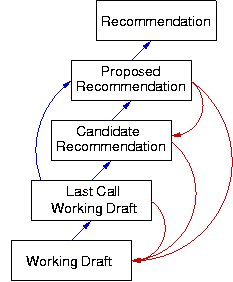World Wide Web Consortium, W3C
Leading the Web to Its Full Potential...
- International vendor-neutral industry consortium (currently ~400 Members)
- Evolution and interoperability of the Web:
for everyone, everywhere on every thing
- Operates from: MIT, ERCIM, and Keio
- Develops key Web technologies such as:
HTML, CSS, XML, SVG, SMIL, ...
Web Accessibility Initiative, WAI
Operates under the W3C Process to provide:
- Accessibility support in W3C technologies
- Guidelines for implementing accessibility
- Methods for evaluating accessibility
- Conducting education and outreach
- Coordinating with research and development world wide
Why WCAG 2.0?
- WCAG 1.0 published 5 May 1999
- WCAG 1.0 is HTML and CSS centric
- WCAG 1.0 has assumptions about user agents
- WCAG 1.0 is sometimes ambigous or unclear
- The Web has evolved a lot since 1999
Good news: basic requirements of people with disabilities hardly changed; WCAG 1.0 is still a very good start
W3C Rec Track

WCAG 2.0 Structure
- Principle
- Guideline
- Level 1
- Success Criteria
- (Technology-specific techniques)
- Level 2
- Success Criteria
- (Technology-specific techniques)
- Level 3
- Success Criteria
- (Technology-specific techniques)
Example #1
- Principle 1: Content must be perceivable
- Guideline 1.4: Make it easy to distinguish foreground information from its background
- Level 1 Success Criteria for Guideline 1.4
- (No level 1 success criteria for this guideline.)
- Level 2 Success Criteria for Guideline 1.4
- 1.4.1 Text or diagrams, and their background, have a luminosity contrast ratio of at least 5:1.
- 1.4.2 A mechanism is available to turn off background audio that plays automatically, without requiring the user to turn off all audio.
- Level 3 Success Criteria for Guideline 1.4
- 1.4.3 Text or diagrams, and their background, have a luminosity contrast ratio of at least 10:1.
- 1.4.4 Audio content does not contain background sounds, background sounds can be turned off, or background sounds are at least 20 decibels lower than the foreground audio content, with the exception of occasional sound effects.
WCAG 2.0 Documents
- W3C Recommendation (status: Last Call)
- Supporting documents (status: Working Drafts)
Example #2
- WCAG 1.0 Checkpoint
- 2.2 Ensure that foreground and background color combinations provide sufficient contrast when viewed by someone having color deficits or when viewed on a black and white screen
- WCAG 2.0 Success Criteria
- 1.4.1 Text or diagrams, and their background, have a luminosity contrast ratio of at least 5:1
- 1.4.3 Text or diagrams, and their background, have a luminosity contrast ratio of at least 5:1
Understanding WCAG 2.0: examples of evaluation tools that implement the luminosity contrast ratio algorithm.
Example #3
- WCAG 1.0 Checkpoint
- 13.1 Clearly identify the target of each link
- WCAG 2.0 Success Criteria
- 2.4.4 Each link is programmatically associated with text from which its purpose can be determined.
- 2.4.8 The purpose of each link can be programmatically determined from the link
Understanding WCAG 2.0: "The intent of this success criterion is to help users understand the purpose of each link in the content, so they can decide whether they want to follow the link [...]"